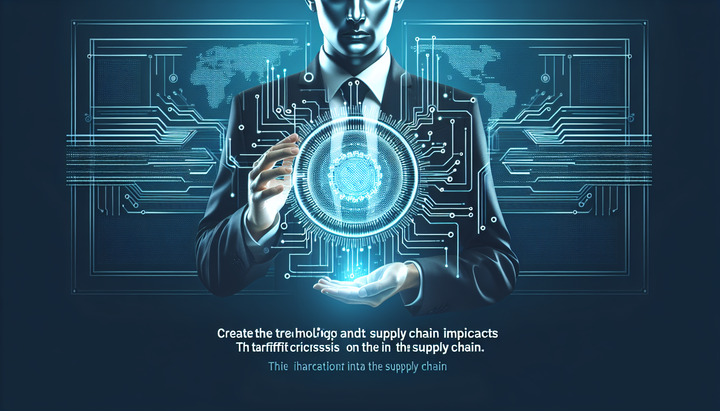Will Decentralized AI Propel Semiconductor Revamp?

Introduction: Navigating Market Volatility and Emerging Tech
The global technology landscape is experiencing unprecedented volatility. Recent market turbulence—exemplified by steep declines in tech giants such as Apple, Tesla, and leading semiconductor stocks—has left investors questioning the future trajectory of the tech industry. Amid these uncertainties, emerging technologies like decentralized AI and 5G edge networks offer promising avenues for reinvigoration. This article explores how these innovations could fundamentally reshape the semiconductor market and drive a broader tech revolution.
The Impact of Tariff Uncertainty on Tech Stocks
Over the past few trading sessions, market dynamics have been heavily influenced by tariff speculations and escalating trade uncertainties. As tariffs loom and negotiations drag on without a definitive resolution, stocks have experienced extreme fluctuations. The tech-heavy Nasdaq, which once rallied on hope and optimism, has since retraced significant gains. For example, semiconductor companies, despite being initially shielded from tariffs, now face demand uncertainties due to potential further tariffs and broader economic slowdowns.
Decentralized AI: A New Paradigm in Technology Innovation
Decentralized AI represents a significant shift from conventional, centralized processing systems. By leveraging distributed networks, decentralized AI systems can reduce latency, increase security, and improve scalability. In environments where data privacy and swift decision-making are paramount, such as in semiconductor production or IoT ecosystems, decentralized AI is rapidly gaining ground.
5G Edge Networks and Their Role in Semiconductor Evolution
The convergence of 5G edge networks with decentralized AI is a game changer. Traditionally, semiconductor companies have relied on centralized computing architectures that can be slow and cumbersome when processing real-time data. However, the introduction of 5G technology has enabled faster data transfers and reduced latency, creating fertile ground for AI-driven innovations. This synergy can lead to:
- Enhanced real-time processing at the network’s edge
- Streamlined semiconductor manufacturing with predictive maintenance
- Improved integration of smart sensors and IoT devices
Innovative Technologies Reshaping the Industry
Beyond decentralized AI and 5G edge networks, several other breakthrough technologies are contributing to the recalibration of the semiconductor market. These include:
- Neuromorphic Computing: Mimicking the human brain’s architecture to deliver energy-efficient processing solutions.
- Silicon Photonics: Using light for data transmission, this innovation promises faster and more efficient chip communication.
- Post-Quantum Cryptography: Offering enhanced security measures as computing power grows, essential for protecting sensitive data.
- Blockchain-Based IoT Security: Integrating blockchain technology to secure interconnected devices and prevent cyber breaches.
- AI-Generated Programming: Accelerating software and firmware development through machine learning techniques.
Case Studies and Research-Backed Insights
Recent studies from high-authority sources such as MIT Tech Review, IEEE publications, and research articles on ArXiv have begun to illustrate the transformative potential of these emerging technologies. For instance, a recent whitepaper by a leading semiconductor manufacturer detailed how integrating decentralized AI into chip design can reduce energy consumption by up to 30% while increasing processing speed. Similarly, industry case studies show that companies leveraging 5G edge networks have observed significant improvements in data management workflows and operational efficiencies.
The Intersection of Market Forces and Technological Breakthroughs
While market forces such as tariff impositions and economic slowdowns impart a cautionary note, the technological breakthroughs in decentralized AI and associated fields offer a counterbalance. Companies are increasingly investing in next-generation research and development to stay ahead of the curve. Key market trends include:
- Increased R&D Spending: With rising competition among tech giants, investment in innovative research is at an all-time high.
- Strategic Collaborations: Partnerships between established companies and startup innovators are fostering rapid development and deployment of breakthrough technologies.
- Shift in Consumer Demand: As consumers demand faster, more secure, and more efficient technology, firms are realigning their strategies towards emerging tech solutions.
Market Speculation and the Role of Policy
The intricate dance between market speculation and government policies is crucial in determining the pace of technological adoption. Tariff uncertainty has had a pronounced negative impact on market sentiment, particularly for technology stocks. However, experts argue that rather than a deterrent, these challenges serve as an impetus for the industry to accelerate its focus on long-term innovations such as decentralized AI and edge computing.
The Future Outlook: Transforming Challenges into Opportunities
Looking forward, the semiconductor market is poised for dramatic transformation. The integration of emerging technologies not only mitigates the risks posed by volatile market forces but also opens new avenues for growth. Some potential future trends include:
- Enhanced Device Autonomy: Through decentralized AI, devices can operate more independently without reliance on centralized data centers.
- Greater Energy Efficiency: Innovations like neuromorphic computing and silicon photonics are set to reduce the energy footprint of semiconductor devices significantly.
- Resilient Data Security: With advancements in post-quantum cryptography and blockchain-based IoT security, future systems will be better protected against cyber attacks.
- Faster Innovation Cycles: AI-generated programming and distributed computing models will shorten development times, leading to faster time-to-market for new products.
Expert Opinions on the New Tech Frontier
Industry experts are increasingly optimistic about the potential of these disruptive technologies. According to a panel discussion hosted by IEEE and cited in MIT Tech Review, the convergence of decentralized AI with 5G edge networks could herald a new era in semiconductor efficiency and capabilities. Experts emphasize that while short-term market volatility is inevitable, the long-term benefits of these technological investments far outweigh the risks.
Global Implications: A Shift in Power Dynamics
The implications of these innovations go beyond the technology sector. Governments and regulatory bodies worldwide are recognizing the need to foster innovation to maintain global competitiveness. Initiatives aimed at investing in cutting-edge R&D, streamlining regulatory frameworks, and encouraging public-private partnerships are on the rise. These measures are expected to accelerate the transition towards a tech ecosystem that leverages decentralized AI, 5G edge capabilities, and advanced semiconductor technologies.
Challenges and Considerations for Industry Leaders
Despite the promising future, the path to widespread adoption of these technologies is not without challenges. Some of the critical hurdles include:
- Integration Complexity: Incorporating decentralized AI into existing infrastructures requires significant overhauls in design, security, and operations.
- Regulatory Uncertainty: With rapidly evolving technology, regulatory bodies may struggle to keep pace, potentially stifling innovation.
- Cost Implications: The initial investment in state-of-the-art technology may be high, posing budgetary challenges for mid-size firms.
- Talent Shortage: As the demand for experts in emerging fields such as neuromorphic computing and post-quantum cryptography grows, companies may face difficulties in recruiting and retaining talent.
Strategies for Overcoming Market and Technological Challenges
To successfully navigate this shifting landscape, industry leaders must adopt multi-faceted strategies that include:
- Robust R&D Initiatives: Ensuring continuous investment in research and development is essential for staying ahead of the curve.
- Strategic Partnerships: Collaborating with academic institutions, startups, and technology consortia can drive innovation and accelerate the integration of new technologies.
- Agile Business Models: Adapting organizational structures to be agile and responsive to rapid technological changes is a must.
- Enhanced Cybersecurity Measures: With emerging tech come new vulnerabilities; hence, integrating blockchain-based IoT security and advanced cryptographic solutions is paramount.
Conclusion: Embracing a New Industrial Revolution
The current market volatility, underscored by dramatic stock fluctuations and tariff uncertainties, presents both a challenge and an opportunity. While the tech industry grapples with short-term setbacks, the long-term outlook is bright. Investments in decentralized AI, bolstered by advances in 5G edge networks and complementary technologies such as neuromorphic computing and silicon photonics, are setting the stage for a revolutionary transformation in semiconductor design and production.
In essence, today's challenges may well be the catalysts for tomorrow's breakthroughs. As companies adapt their business models, invest in innovative R&D, and forge strategic partnerships, they are not merely weathering the storm—they are laying the foundation for a resilient, technology-driven future. As noted in leading research from IEEE and MIT Tech Review, the successful integration of these emerging technologies could redefine industry standards, making the current period of volatility a stepping stone to sustained market triumph.
For investors and industry professionals alike, staying informed about these trends is crucial. With continuous advancements in AI-generated programming, post-quantum cryptography, and blockchain-based IoT security, the semiconductor market and the broader tech ecosystem are on the brink of a major evolution—one that promises not only recovery from today’s challenges but a leap into a new era of efficiency and innovation.
As the world watches, the shift toward decentralized and edge-driven solutions is gathering momentum. It is an exciting time to be part of an industry replete with both immense challenges and even greater opportunities. The future of technology is not being written by market whims alone, but by deliberate, visionary advancements that have the power to transform not just an industry, but the fabric of our digital society.
For more detailed insights and ongoing updates, industry professionals are encouraged to consult reputable sources such as IEEE, MIT Tech Review, and recent studies available on ArXiv. These platforms provide a continuous stream of in-depth analyses and empirical data, ensuring that stakeholders remain well-informed as the tech landscape evolves.



Comments ()